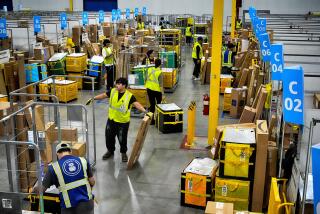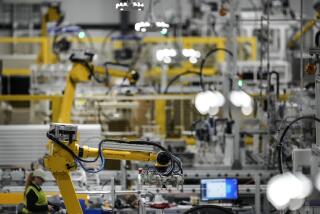China’s torrid growth cools
SHANGHAI — China’s economic growth rate fell sharply in the fourth quarter, sapped by weakening investments and exports that signal rockier times ahead for the world’s third-largest economy, as well as the many nations that have come to rely on it.
The Chinese government said today that its gross domestic product, or economic output, rose 6.8% in the final quarter of 2008 from a year earlier. That was the lowest quarterly growth rate in seven years and a marked slowing from the previous quarter’s 9% advance.
The deceleration dragged down the country’s annual growth to 9%, well below the 13% increase for all of 2007.
China’s exports, which had been booming month after month by 20% to 40% in recent years, contracted in November and December as orders fell sharply from ailing U.S. and European economies.
A deteriorating Chinese economy would be disheartening for the global economy and particularly worrisome for trading partners in the Asia-Pacific region whose fortunes are closely tied to China.
South Korea and Singapore both reported this week that their economies contracted in the fourth quarter from the third quarter. Taiwan, Hong Kong and Australia, among others, also are hurting partly because of a pullback in business from China.
Significantly, China’s growth in the final three months fell below the 8% figure that analysts say is generally needed to provide enough jobs for China’s huge labor market. Signs indicate that the nation’s unemployment rate has risen in recent months -- and with it the risks of social instability -- because of massive layoffs by manufacturers hit hard by the global financial crisis.
Zhu Baoliang, chief economist of the State Information Center, a government think tank, said the 6.8% growth rate was still too slow. A 7% growth rate will provide only 6.4 million new jobs, Zhu said, not nearly enough to meet the employment needs of fresh graduates.
“For ordinary people,” he added, “that means there will be a large impact on their employment. There are still large challenges.”
A government official said the growth rate still outshone other nations’, given difficulties last year that included the Sichuan earthquake and the worst winter storm in decades. China contributed 20% to the world’s economic growth last year, said Ma Jiantang, head of the National Bureau of Statistics, which released the figures.
China’s central government, trying to avert the sort of hard landing that many other nations have endured, has taken a number of steps to stimulate domestic demand and help its struggling exporters. For instance, it has pledged hundreds of billions of dollars for infrastructure projects, lowered interest rates and halted the appreciation of the nation’s currency, which had made Chinese goods more expensive in overseas markets.
“I can responsibly tell all our friends that I am full of confidence in China’s economy in 2009 and in the future,” Ma told reporters in Beijing.
Nonetheless, some analysts predict that China’s economic growth this year will tail off further to an annual rate of 5.5%. Net exports accounted for about one-fifth of China’s economic growth in 2007, but that could fade in 2009 as demand from the U.S. and Europe erodes, in turn prompting Chinese companies to cut costs and reduce investments. Investments and consumer spending each made up roughly 40% of China’s GDP growth.
Retail sales grew 19% year over year in December, the slowest in more than a year.
--
More to Read
Inside the business of entertainment
The Wide Shot brings you news, analysis and insights on everything from streaming wars to production — and what it all means for the future.
You may occasionally receive promotional content from the Los Angeles Times.











